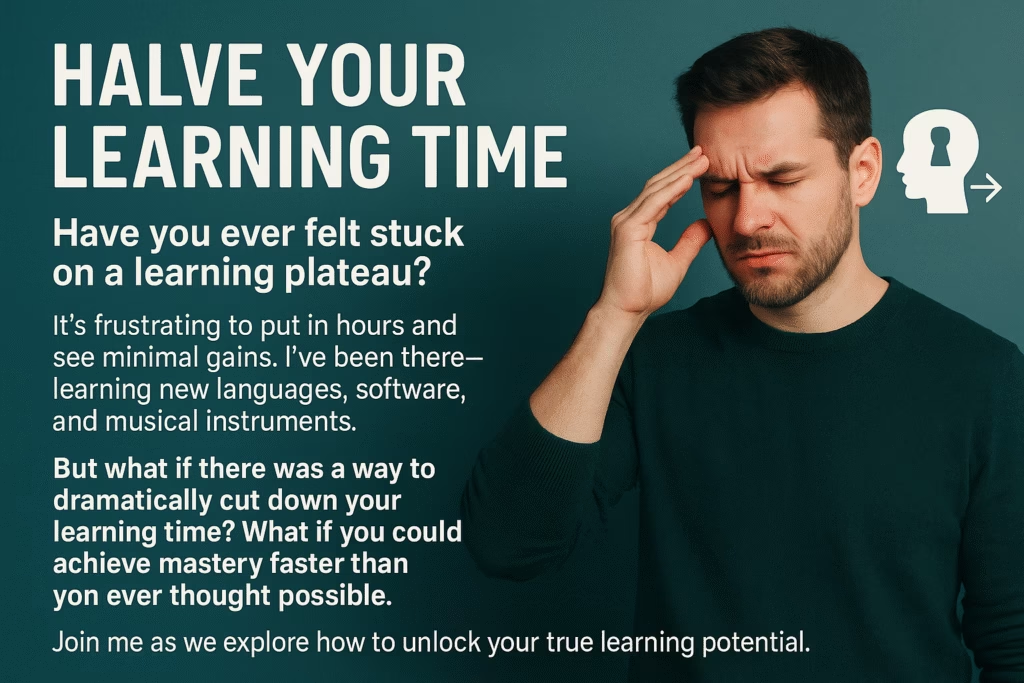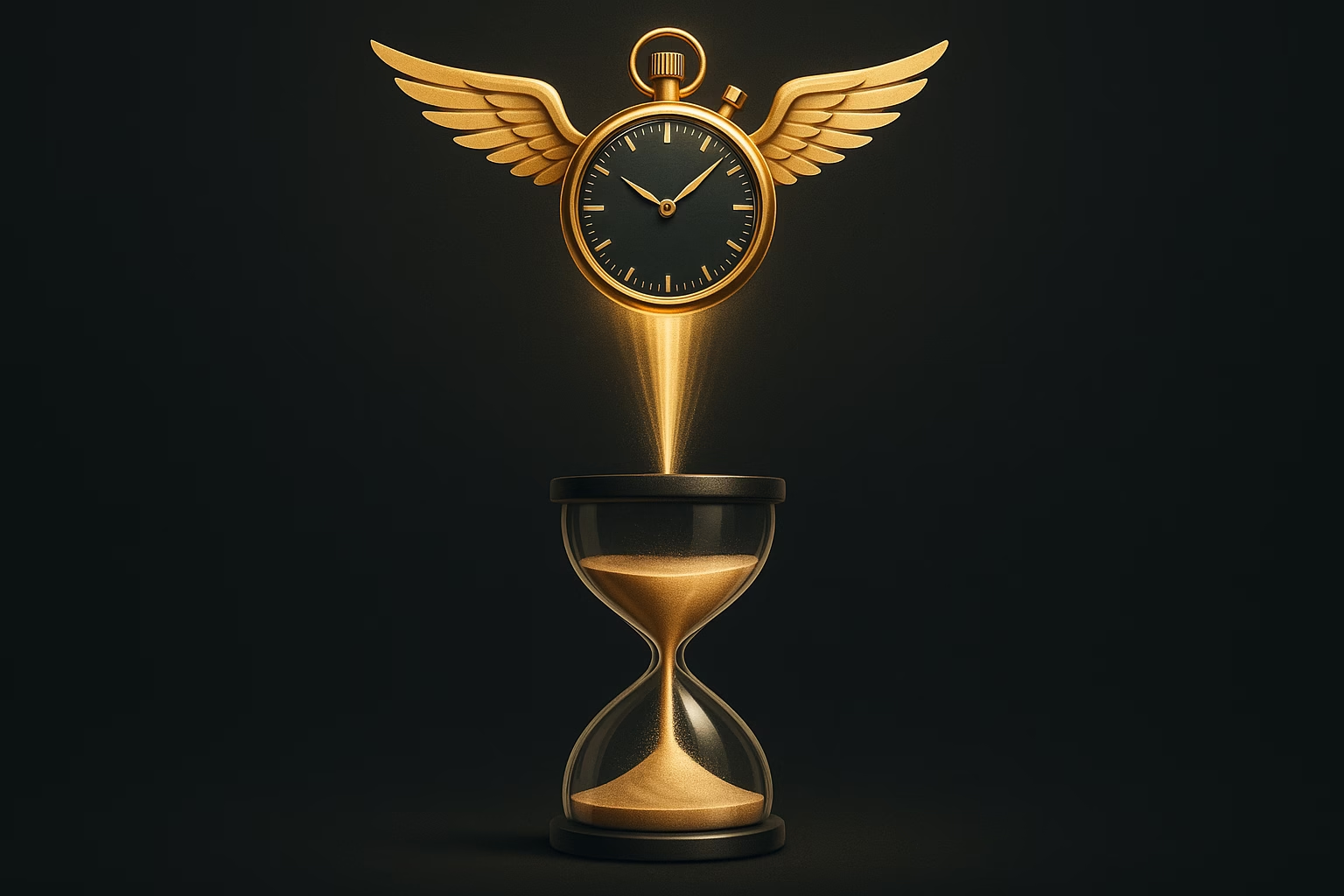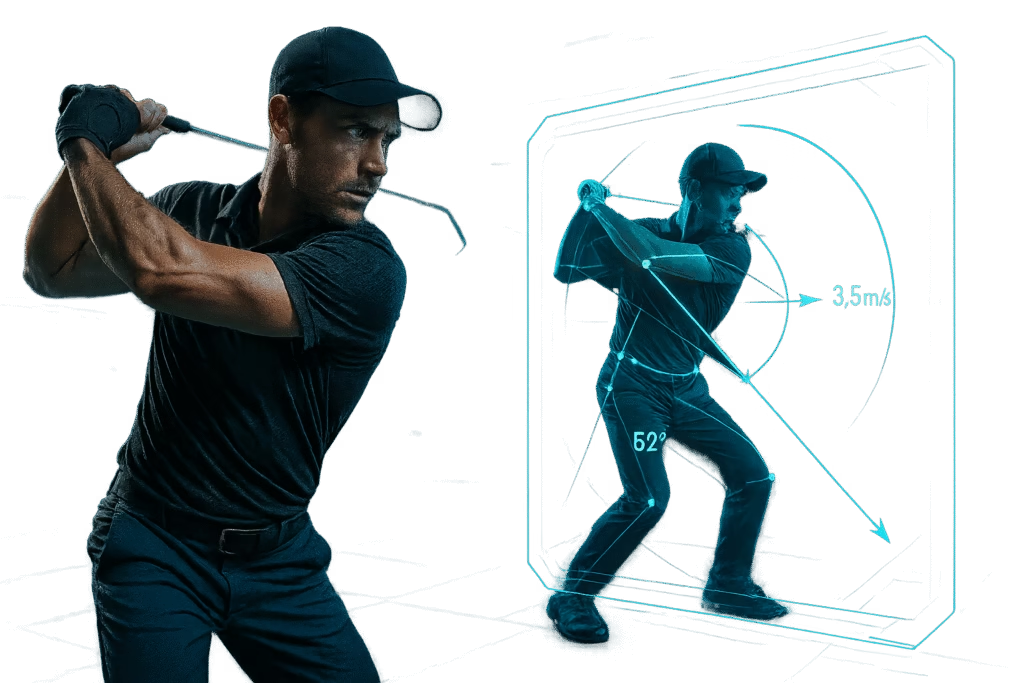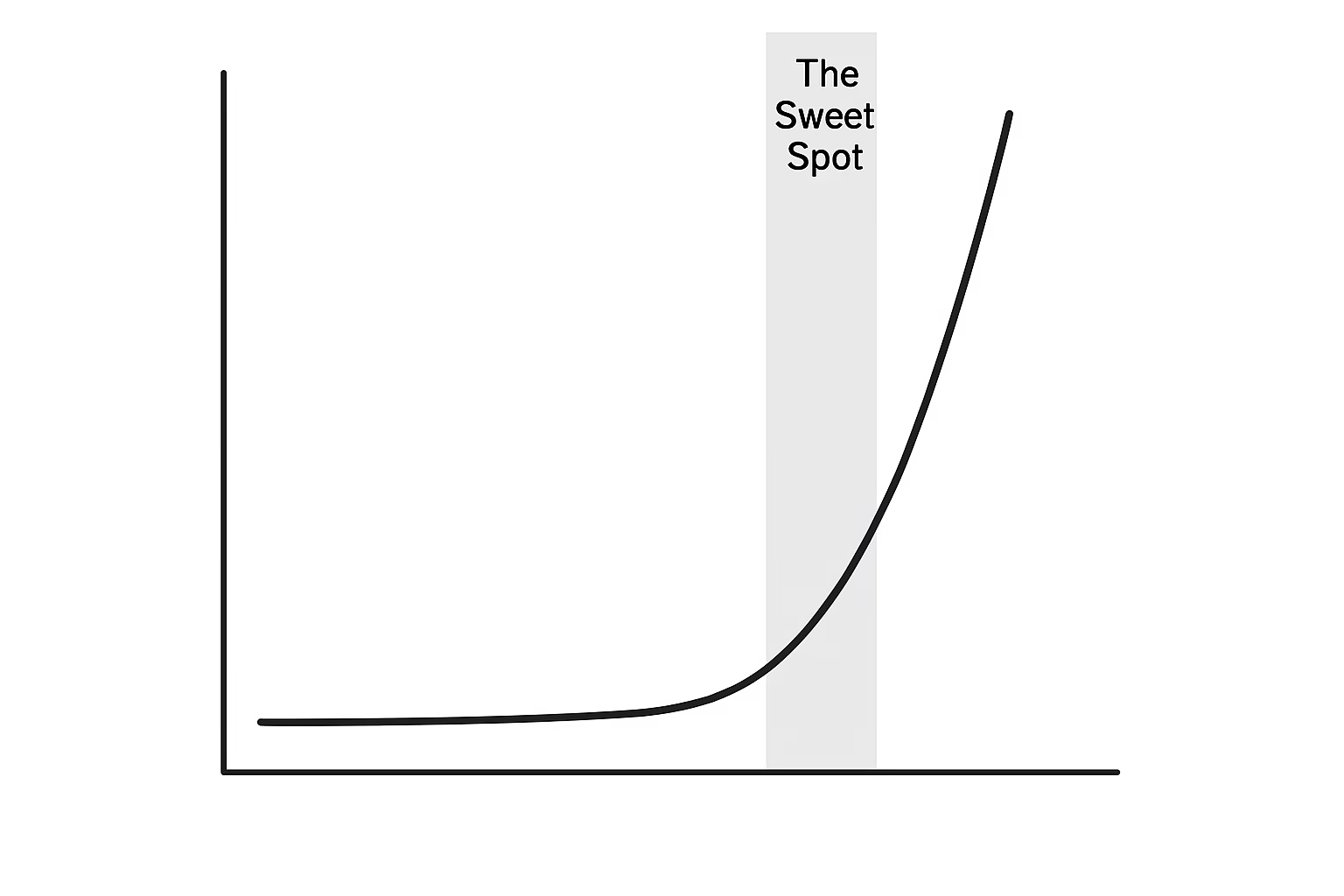
Have you ever felt stuck on a learning plateau? It’s frustrating to put in hours and see minimal gains. I’ve been there—learning new languages, software, and musical instruments. But what if there was a way to dramatically cut down your learning time? What if you could achieve mastery faster than you ever thought possible? Join me as we explore how to unlock your true learning potential.
Stop Wasting Hours: Why Quality Over Quantity Halves Your Learning Time
In today’s fast-paced world, learning new skills quickly is essential. Yet, many of us learn in ways that are inefficient. We often think that more hours mean more progress. In reality, it is the quality of those hours that truly matters.
What if you could cut your learning time in half? What if you could achieve a deeper, stronger understanding? This is not just a dream; it’s the promise of Deep Practice.
The Lie of “Effort” vs. The Strength of “Depth”
Think about how you typically learn something new. Maybe you read a book, watch a tutorial, or repeat a task many times. These actions are useful, but they often fail to boost your learning speed. We often confuse “hard work” with “smart work.” We spend hours just receiving information or doing things mindlessly. Then we are surprised when our skills do not grow fast enough.
Deep Practice, a concept made famous by Daniel Coyle, completely changes this old way of learning. It’s not about how much you practice, but how you practice. It’s a very focused type of learning. It actively targets your flaws, pushes you to the very edge of your current ability, and builds strong brain pathways.
The main idea is simple yet powerful: true learning happens when you are always working at the edge of your skill. You must make mistakes, and then fix them. This struggle is not a sign of failure. It is the engine that speeds up your progress.
What Exactly Is Deep Practice? The Core Rules

Deep Practice is not a single tool. It is a philosophy built on key rules. Knowing these will help you use Deep Practice for almost any learning goal.
1. The Sweet Spot: Working at Your Skill Limit
This is the most important part. Deep Practice happens when you always push yourself just past what you can do easily. If a task is too simple, you are not learning. You are just repeating old habits. If a task is too hard, you will get frustrated and quit. The “sweet spot” is the tough zone. Here, you make errors, but you can also find and correct them. This is where your brain actively builds new connections.
- Example: If you learn a new language, do not just review words you know. Try to build sentences using new grammar rules and words you are unsure about. You will make errors. But the act of trying and fixing those errors is where you learn deeply.
2. Smart Repetition: The “Mistake-Focus” Method
Deep Practice is not senseless repetition. It is about focused, smart repetition. You find one specific weakness or hurdle. You focus hard on fixing it. Then you try again, making small changes each time based on your last errors.
- Example: A musician does not just play a song repeatedly. They find a hard part. And play it slowly. They isolate the tough chord changes. And then speed it up a little, and they repeat only that short section. They do this until it is smooth. Then they put it back into the song. They are actively looking for and fixing errors.
3. High-Quality Feedback: Inside and Out
To get better, you must know what you are doing wrong. More importantly, you must know why. Feedback comes from several places:
- Internal: Your own honest review. (e.g., “That chord was bad,” “My body felt off-balance.”)
- External: A teacher, mentor, friend, or even a tool that gives you clear facts. (e.g., a golf sensor, a language tutor, a code checker).
- Example: A basketball player records their free throws. They watch the video. They notice their elbow moves out. This outside view helps them adjust their feeling for the correct shot form.
4. The Power of “Chunking”: Making Things Simple
Complex skills can feel too big to handle. Deep Practice suggests breaking a big skill into smaller, easy-to-manage “chunks.” Master each chunk one by one. Then connect them together. This lets your brain build skill in small steps. It makes the whole skill seem less scary.
- Example: Learning to build a complex software app can feel huge. Instead, you first learn how to take user input (chunk 1). Then you learn how to show data (chunk 2). Then you learn how to connect to a database (chunk 3). You slowly join these parts. You master one piece before moving to the next.
5. Keep Going and Be Patient: Love the “Struggle”
Deep Practice is often hard. It can feel frustrating because you always make errors. But this struggle is the signal of growth. Persistence means more than just showing up. It means staying engaged and thoughtful, even when you do not succeed right away.
- Example: Learning to juggle three balls means dropping them, again and again. A Deep Practitioner knows these drops are not failures. They are key bits of info that show where to make changes. They keep trying, knowing each drop makes their hand skills better.
How Deep Practice Changes Your Brain: Myelin and Pathways

The science behind Deep Practice is amazing. It is based on brain biology. When you practice in a tough, focused way, you are building and strengthening the nerve circuits for that skill.
Specifically, Deep Practice helps grow myelin. This is a fatty shield around nerve fibers (axons) in your brain. Think of myelin like the plastic cover around an electric wire. More myelin means electrical signals (information) move faster and more smoothly. When you push yourself and fix errors, your brain adds more myelin around the right nerve circuits. This makes them work quickly and surely.
This means Deep Practice does not just make you better at a skill. It makes your brain more efficient at doing that skill. This is why experts can do hard things with great speed and ease. Their brain pathways are heavily shielded with myelin.
How to Use Deep Practice: A Simple Guide

Ready to halve your learning time? Here is how you can use Deep Practice in your daily learning, for any skill you want to gain.
Step 1: Name Your Skill and Break It Down
- What to do: Clearly say what skill you want to improve. Then, break it into its smallest, most basic parts or “chunks.”
- How to do it: If learning guitar, do not think “play guitar.” Think “master the C chord,” then “move smoothly from C to G,” then “fingerpicking pattern one.” If learning to write, it might be “write a strong opening,” “structure an argument,” or “write short sentences.”
Step 2: Find Your Weakest Link (The “Sweet Spot”)
- What to do: Find the specific part within a chunk that is the hardest. This is where you make the most mistakes. This is your current “sweet spot” for growth.
- How to do it: Be honest with yourself. If learning new software, is it remembering the quick keys, understanding one function, or fixing errors? If learning a sport, is it your backhand, your serve, or your footwork?
Step 3: Focus Hard and Use “Mistake-Focused” Repetition
- What to do: Spend a practice session on only that weak link. Go slowly. Pay close attention. Do not be afraid to make errors. Each error is key information.
- How to do it:
- Go Slow: If learning a dance move, do it in slow motion. If learning a math formula, write out every single step.
- Isolate: Practice only the hard part. Do not do the whole sequence.
- Change It Up: Do not just do the same thing. Try a slightly different position, speed, or method. What if I move my hand just here? What if I use this other word order?
- Picture It: Before you try, see the perfect action in your mind.
Step 4: Get and Use High-Quality Feedback
- What to do: Actively look for facts that tell you how well you are doing and how to improve.
- How to do it:
- Fix Yourself: After each try, stop and think. What went wrong? Why? How can I change it?
- Record Yourself: Video or audio gives you an unbiased view of your work.
- Get a Teacher: An experienced person can spot problems and give targeted advice.
- Use Tools: Apps, software data, or special gear can give you facts-based feedback.
Step 5: Embrace the Struggle and Keep Going
- What to do: Know that feeling annoyed and failing are normal parts of Deep Practice. They show that you are in the learning zone.
- How to do it:
- Have a Growth Mindset: See tough moments as chances to improve, not as walls.
- Short, Intense Blocks: A 20-30 minute block of Deep Practice is better than 2 hours of weak learning.
- Be Regular: Doing it often is better than doing it for a long time only once in a while.
- Be Proud of Small Wins: Notice when you finally get that tough part right or understand a complex idea.
Step 6: Join It All Up
- What to do: Once you have mastered a chunk, put it back into the larger skill. Practice the movement between the chunks.
- How to do it: If you mastered the C chord, now practice moving from C to G, and then G to D. If you learned how to write a good opening, now practice writing that opening and connecting it smoothly to your main point.
Real-World Examples of Deep Practice at Work

Deep Practice is not just for top athletes or great musicians. It is a key rule that works in any field.
Coding:
A junior coder learning a new programming tool does not just read the manual. They choose a small, hard feature to build, like a user login system. And write the code. When they run into errors. They carefully fix each one. Then check the guide for specific functions. They try again until it works. This hands-on, problem-solving method is Deep Practice.
Learning a New Language:
Instead of just learning verb charts, a language student might try to speak for five minutes using only the past tense. They will stumble and make many errors. While pushing themselves to use the grammar right now. They get instant feedback from the effort to talk.
Public Speaking:
Someone who wants to speak better in public will not just practice in their head. They will record themselves giving a certain part of a speech. And watch it back. They find any strange pauses or filler words. Then they re-record that exact part, focusing only on fixing those issues.
Sports:
A tennis player who has trouble with their serve will not just hit 100 balls without a goal. They will work with a teacher. And focus on one thing (like the wrist snap). They hit a few serves. And get feedback. They adjust. They repeat this, trying to feel the correct movement.
Fixing Common Deep Practice Problems

Deep Practice is not always simple. Here are some common problems and how to get past them:
- Frustration: This is a good sign! It means you are pushing your limits. Remember that struggle equals growth. Take short breaks and return with strong focus.
- No Feedback: Go find it! Record yourself. Ask a friend who knows the subject. Use tools online.
- Getting Off Track: Deep Practice needs intense focus. Set up a place with no distractions. Plan short, specific time blocks for practice.
- Do not Know What to Practice: If you are stuck, go back to Step 1 & 2. Break the skill down more. Or ask experts for advice on the basic parts you need to learn.
Conclusion: Your Fast Path to Mastery

Halving your learning time is not about finding a magic trick. It is about choosing a much better way to learn. By using the rules of Deep Practice—working at your skill limit, repeating with a focus on mistakes, using feedback, and dealing with the struggle—you can unlock your brain’s huge power for fast skill growth.
Stop working harder and start working smarter. The ability to learn quickly and deeply is one of the best skills you can have. Accept the challenge, enjoy the process, and watch your learning time decrease as your skill level speeds up.
Frequently Asked Questions (FAQ)
Q1: Is Deep Practice only for body skills like sports or music?
A1: Not at all! While you see it in those areas, Deep Practice works well for mental skills too. This includes coding, writing, languages, solving problems, and thinking strategically. The rules of pushing your limits and smart repetition work everywhere.
Q2: How long should a Deep Practice session be?
A2: Quality is more important than amount. A 20 to 30 minute session of strong, focused Deep Practice is often better than an hour of passive learning. You want to stay in that “sweet spot” at the edge of your ability without getting too tired. Shorter, more frequent sessions are usually best.
Q3: Can I mix Deep Practice with other learning methods?
A3: Yes, completely! Deep Practice works well with other methods. For example, you can use passive learning (like reading a book) to grasp an idea. Then you use Deep Practice to actively use and internalize it. You can also schedule your Deep Practice sessions using spaced repetition systems.
Q4: How do I know if I’m doing Deep Practice the right way?
A4: You are in the Deep Practice zone if you feel challenged. You should be making errors and then actively trying to fix them. It should not feel simple or automatic. If it feels too easy, you are likely not pushing yourself enough. The key is the struggle followed by making changes.
Q5: What if I do not have a coach or teacher for feedback?
A5: While a coach is great, you can get good feedback in other ways. Record yourself (video or audio). Ask a knowledgeable friend to watch. Or judge your own work very carefully after each attempt. The important thing is to clearly see what went wrong and how to improve.
References
- Psychologytoday – The Best Way to Learn a New Skill? Go Deep
- Shortform – What Is Deep Practice and Why Is It Important?
Recent Posts


